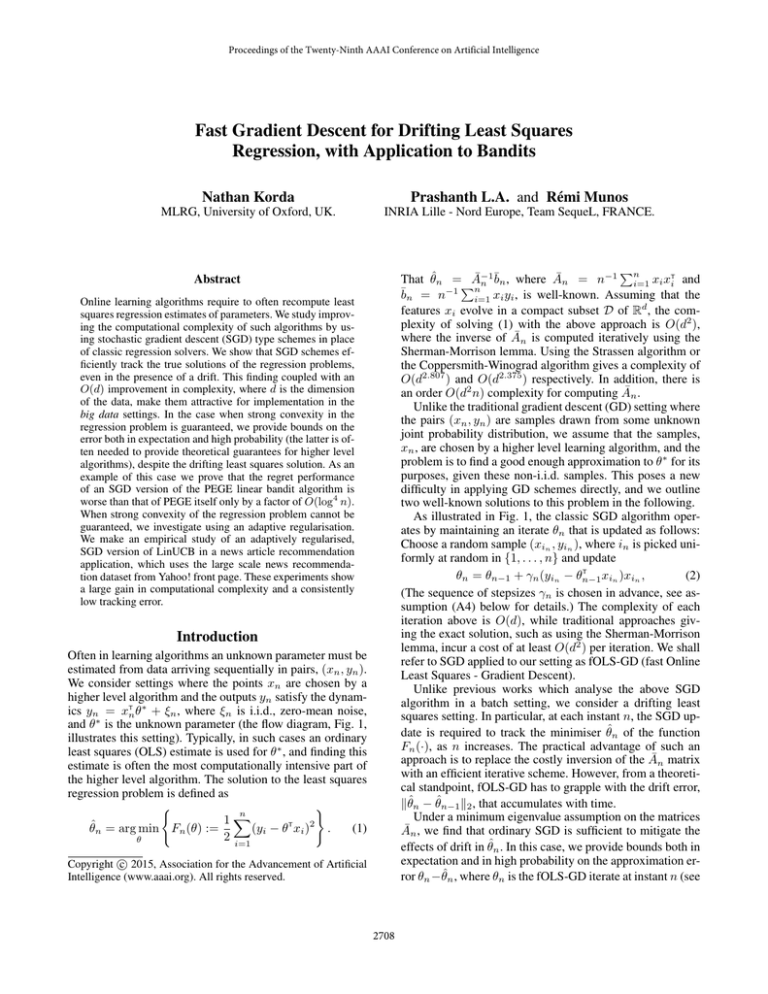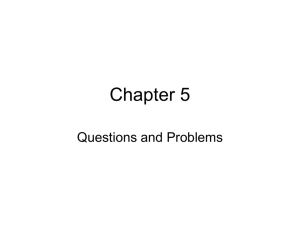
Proceedings of the Twenty-Ninth AAAI Conference on Artificial Intelligence
Fast Gradient Descent for Drifting Least Squares
Regression, with Application to Bandits
Nathan Korda
Prashanth L.A. and Rémi Munos
MLRG, University of Oxford, UK.
INRIA Lille - Nord Europe, Team SequeL, FRANCE.
Pn
−1
T
That θ̂n =PĀ−1
n b̄n , where Ān = n
i=1 xi xi and
n
−1
b̄n = n
i=1 xi yi , is well-known. Assuming that the
features xi evolve in a compact subset D of Rd , the complexity of solving (1) with the above approach is O(d2 ),
where the inverse of Ān is computed iteratively using the
Sherman-Morrison lemma. Using the Strassen algorithm or
the Coppersmith-Winograd algorithm gives a complexity of
O(d2.807 ) and O(d2.375 ) respectively. In addition, there is
an order O(d2 n) complexity for computing Ān .
Unlike the traditional gradient descent (GD) setting where
the pairs (xn , yn ) are samples drawn from some unknown
joint probability distribution, we assume that the samples,
xn , are chosen by a higher level learning algorithm, and the
problem is to find a good enough approximation to θ∗ for its
purposes, given these non-i.i.d. samples. This poses a new
difficulty in applying GD schemes directly, and we outline
two well-known solutions to this problem in the following.
As illustrated in Fig. 1, the classic SGD algorithm operates by maintaining an iterate θn that is updated as follows:
Choose a random sample (xin , yin ), where in is picked uniformly at random in {1, . . . , n} and update
T
θn = θn−1 + γn (yin − θn−1
xin )xin ,
(2)
(The sequence of stepsizes γn is chosen in advance, see assumption (A4) below for details.) The complexity of each
iteration above is O(d), while traditional approaches giving the exact solution, such as using the Sherman-Morrison
lemma, incur a cost of at least O(d2 ) per iteration. We shall
refer to SGD applied to our setting as fOLS-GD (fast Online
Least Squares - Gradient Descent).
Unlike previous works which analyse the above SGD
algorithm in a batch setting, we consider a drifting least
squares setting. In particular, at each instant n, the SGD update is required to track the minimiser θ̂n of the function
Fn (·), as n increases. The practical advantage of such an
approach is to replace the costly inversion of the Ān matrix
with an efficient iterative scheme. However, from a theoretical standpoint, fOLS-GD has to grapple with the drift error,
kθ̂n − θ̂n−1 k2 , that accumulates with time.
Under a minimum eigenvalue assumption on the matrices
Ān , we find that ordinary SGD is sufficient to mitigate the
effects of drift in θ̂n . In this case, we provide bounds both in
expectation and in high probability on the approximation error θn − θ̂n , where θn is the fOLS-GD iterate at instant n (see
Abstract
Online learning algorithms require to often recompute least
squares regression estimates of parameters. We study improving the computational complexity of such algorithms by using stochastic gradient descent (SGD) type schemes in place
of classic regression solvers. We show that SGD schemes efficiently track the true solutions of the regression problems,
even in the presence of a drift. This finding coupled with an
O(d) improvement in complexity, where d is the dimension
of the data, make them attractive for implementation in the
big data settings. In the case when strong convexity in the
regression problem is guaranteed, we provide bounds on the
error both in expectation and high probability (the latter is often needed to provide theoretical guarantees for higher level
algorithms), despite the drifting least squares solution. As an
example of this case we prove that the regret performance
of an SGD version of the PEGE linear bandit algorithm is
worse than that of PEGE itself only by a factor of O(log4 n).
When strong convexity of the regression problem cannot be
guaranteed, we investigate using an adaptive regularisation.
We make an empirical study of an adaptively regularised,
SGD version of LinUCB in a news article recommendation
application, which uses the large scale news recommendation dataset from Yahoo! front page. These experiments show
a large gain in computational complexity and a consistently
low tracking error.
Introduction
Often in learning algorithms an unknown parameter must be
estimated from data arriving sequentially in pairs, (xn , yn ).
We consider settings where the points xn are chosen by a
higher level algorithm and the outputs yn satisfy the dynamics yn = xTn θ∗ + ξn , where ξn is i.i.d., zero-mean noise,
and θ∗ is the unknown parameter (the flow diagram, Fig. 1,
illustrates this setting). Typically, in such cases an ordinary
least squares (OLS) estimate is used for θ∗ , and finding this
estimate is often the most computationally intensive part of
the higher level algorithm. The solution to the least squares
regression problem is defined as
)
(
n
1X
T
2
(yi − θ xi ) .
(1)
θ̂n = arg min Fn (θ) :=
2 i=1
θ
c 2015, Association for the Advancement of Artificial
Copyright Intelligence (www.aaai.org). All rights reserved.
2708
Theorem 1). Such bounds are essential for giving theoretical
guarantees when using fOLS-GD as a subroutine to replace
the matrix inversion approach to the regression problem in a
higher level learning algorithm.
To cope with situations where the minimum eigenvalue
assumption of the Ān matrix cannot be guaranteed by the
higher level algorithm we propose adding an adaptive regularisation: since our data is growing with time we introduce
a regularisation parameter, λn , that adapts to the sample size
n as follows:
n
1 X
2
θ̃n := arg min
(yi − θT xi )2 + λn kθk2 . (3)
θ 2n
i=1
Choose xn
Observe yn
Use θn to estimate θ̂n
θn
Pick random
sample in
Update θn
using (2)
Random Sampling
GD Update
θn+1
Figure 1: Estimating OLS θ̂n using online SGD within a
higher-level machine learning algorithm
This algorithm, which we henceforth refer to as fRLS-GD
(fast Regularised online Least Squares - Gradient Descent),
tracks the regression solutions, θ̃n and operates in a manner
similar to fOLS-GD (see Fig. 1) except that we factor in the
regularisation parameter λn into the update rule:
T
θn = θn−1 + γn ((yin − θn−1
xin )xin − λn θn−1 ). (4)
Unlike fOLS-GD, the above algorithm will suffer a bias due
to the adaptive regularisation and it is difficult to provide
bounds in theory owing to the bias error (see discussion after
Eq. (10)). However, we demonstrate empirically that fRLSGD is able to consistently track the true RLS solutions, when
used within a higher level algorithm. The advantage, however, of using fRLS-GD in place of classic RLS solvers is
that it results in significant computational gains.
As examples of higher level learning algorithms using regression as a subroutine, we consider two linear bandit algorithms. In a linear bandit problem the values xn represent
actions taken by an agent and the values yn = xTn θ∗ + ξn are
interpreted as random rewards, with unknown parameter θ∗ .
At each time the agent can choose to take any action x ∈ D,
where D is some compact subset of Rd , and the agent’s goal
is to maximise the expected sum of rewards. This goal would
be achieved by choosing xn = x∗ := arg minx {xT θ∗ },
∀n. However, since one does not know θ∗ one needs to
estimate it, and a tradeoff appears between sampling pairs
(xn , yn ) that will improve the estimate, and gaining the
best short term rewards possible by exploiting the current
information available. Typically the performance of a bandit algorithm
Pn is measured by its expected cumulative regret:
Rn = i=1 (x∗ − xi )T θ∗ .
First, we consider the PEGE algorithm for linear bandits
proposed by (Rusmevichientong and Tsitsiklis 2010). This
algorithm is designed for action sets D satisfying a strong
convexity property (see assumption (A4)), and so we can
provide a computationally efficient variant of PEGE where
the fOLS-GD iterate, θn , is used in place of the OLS estimate, θ̂n , in each iteration n of PEGE. PEGE splits time into
exploration and exploitation phases. During the exploitation
phases the algorithm acts greedily using OLS estimates of θ∗
calculated from data gathered during the exploration phases.
During the exploration phases data is gathered in such a way
that the smallest eigenvalues of Ān matrices are uniformly
bounded for all n. The regret performance of this algorithm
is O(dn1/2 ), and we establish that our variant using fOLSGD as a subroutine achieves an improvement of order O(d)
in complexity, while suffering a loss of only O(log4 n) in
the regret performance.
Second, we consider the LinUCB algorithm proposed (Li
et al. 2010). Here we investigate computationally efficient
variants of LinUCB. We begin by replacing the OLS estimate with an fRLS-GD iterate, and then compare this to
two other state-of-the-art OLS schemes from (Johnson and
Zhang 2013) and (Roux, Schmidt, and Bach 2012). The LinUCB algorithm is designed for situations where at each time,
n, the agent can choose only from a given, finite subset of
D. The algorithm then calculates an optimistic upper confidence bound (UCB) for the mean reward associated with
each feature, and then selects a feature greedily with respect
to this UCB1 .
LinUCB, however, cannot guarantee that the minimum
eigenvalue of Ān matrices is uniformly bounded, and so we
apply fRLS-GD in place of fOLS-GD. Moreover, we devise
a simple GD procedure for estimating the confidence term
of the UCB for each arm. The resulting LinUCB variant
achieves an O(d) improvement in complexity over regular
LinUCB. From the numerical experiments, we observe that
the fRLS-GD iterate as well as SVRG (Johnson and Zhang
2013) and SAG (Roux, Schmidt, and Bach 2012) variants
consistently track the true RLS solutions in each iteration of
LinUCB, while the runtime gains are significant.
Related work. SGD is a popular approach for optimizing a function given noisy observations, while incurring low
computational complexity. Non-asymptotic bounds in expectation for SGD schemes have been provided by (Bach
and Moulines 2011). In the machine learning community,
several algorithms have been proposed for minimising the
regret, for instance, (Zinkevich 2003; Hazan and Kale 2011;
Rakhlin, Shamir, and Sridharan 2011) and these can be converted to find the minimiser of a (usually convex) function.
A closely related field is stochastic approximation (SA),
and concentration bounds for SA algorithms have been provided by (Frikha and Menozzi 2012). Adaptive regulari1
Calculating the UCBs is in itself an NP-hard problem for all
but simple decision sets. However, we alleviate this problem by
considering a setting where the sets of arms at each time instant is
a finite subset of D.
2709
sation in the context of least squares regression has been
analysed in (Tarrès and Yao 2011). For recent algorithmic
improvements to solving batch problems, the reader is referred to the works of (Roux, Schmidt, and Bach 2012;
Shalev-Shwartz and Zhang 2012; Johnson and Zhang 2013).
In general, none of the schemes proposed above are directly applicable in our setting due to two difficulties:
(i) our data {(xi , yi )}ni=1 do not arrive from a distribution,
but instead are chosen by a higher level algorithm, and
(ii) an efficient online scheme is required to track the solution of a least squares regression problem with a growing
data set, and thus a drifting target.
Earlier works solve one batch problem or a sequence of
batch problems with data arriving from a distribution. On
the other hand, we consider a drifting regression setting and
study low complexity SGD schemes. For a strongly convex
setting, we are able to provide theoretical guarantees, while
for a non-strongly convex setting, we obtain encouraging results empirically.
where
p
√
2 + µβn+c
kθn0 − θ∗ k ln(n0 ) p
K1 (n) =
+ h(n) +
,
µ
(n + c)µc/4
r
1
K2 (n) = 2Kµ,c log + K1 (n),
δ
2
Kµ,c =c / [16 (1 − 2(1 − 3µc/16))] ,
2 ,
βn = max 128d log n log n2 δ −1 , 2 log n2 δ −1
h(k) =2 1 + 2(kθn0 − θ∗ k2 + log k)2 .
Proof Sketch In order to prove the bound in expectation,
following the proof scheme of (Frikha and Menozzi 2012),
we expand the error at time n into an initial error term, a
(martingale) sampling error term, and a drift error term as
follows:
θn − θ̂n = θn − θ̂n−1 + θ̂n−1 − θ̂n
T
=θn−1 − θ̂n−1 + θ̂n−1 − θ̂n + γn (yin − θn−1
xin )xin
n
X
Πn
Πn
Πn
=
(θn0 − θ∗ ) +
γk
∆M̃k −
(θ̂k − θ̂k−1 )
Πn0
Πk
Πk
k=n
+1
|
{z
}
|
{z
}
0
{z
}
|
Gradient Descent for Online Least Squares
In this section, we present the results for the fOLS-GD procedure outlined earlier. Recall
Pn that fOLS-GD tracks the OLS
estimate θ̂n := minθ 21 i=1 (yi − θT xi )2 as the samples
(xi , yi ) arrive sequentially (see Fig. 1) and updates the parameter as follows: Fix θ0 arbitrarily and update
T
θn = θn−1 + γn (yin − θn−1
xin )xin ,
Initial Error
Sampling Error
Drift Error
Qn
where Πn := k=1 I − γk Āk , and ∆M̃k is a martingale
difference (see the Appendix A in (Korda, Prashanth, and
Munos 2014) for details).
The initial and sampling errors appear as in previous
works on SGD (cf. (Frikha and Menozzi 2012) and (Bach
and Moulines 2011)), and can be treated similarly, except
that here we can make all the constants explicit,
using the
≤
specific form of the update rule, and also that Πn Π−1
k
2
Pn
exp(Γn − Γk ), where Γn := i=1 γi . In this way, choosing
the step sequence as in the Theorem statement, we derive the
first and second terms of K1 (n).
The drift error, however, is not present in previous works,
and comes from the fact that the target of the algorithm, θ̂n ,
is drifting over time. To control it we note that
∇Fn (θ̂n ) = 0 = ∇Fn−1 (θ̂n−1 ) =⇒
−1
T
∗
θ̂n−1 − θ̂n = ξn A−1
−
(x
(
θ̂
−
θ
))A
n
n
n−1
n−1 xn .
(5)
where in ∼ U({1, . . . , n}). Here U(S) denotes the uniform distribution on the set S, and so the samples (xin , yin )
passed to (5) are chosen uniformly randomly from the set
{(x1 , y1 ), . . . , (xn , yn )}.
Results
following assumptions:
P We make theP
(A1) n γn = ∞ and n γn2 < ∞.
(A2) Boundedness of xn , i.e., supn kxn k2 ≤ 1.
(A3) The noise {ξn } is i.i.d. and |ξn | ≤ 1, ∀n.
(A4) For all n larger than some initial n0 , λmin (Ān ) ≥ µ,
where λmin (·) denotes the smallest eigenvalue of a matrix.
The first assumption is a standard one for the step sizes
of SGD, and, more generally, stochastic approximation
schemes. While the next two assumptions are standard in the
context of least squares, the last assumption is made necessary due to the fact that we do not regularise the problem.
Initially An may not invertible, and hence the condition can
only reasonably hold after some initial time n0 .
In the following, we bound the approximation error kθn −
θ̂n k of fOLS-GD, both in high probability as well as in expectation.
Thus it is controlled by the convergence of the least squares
solution θ̂n to θ∗ . Adapting a confidence ball result from
(Dani, Hayes, and Kakade 2008), we derive the third term
of K1 .
Having bounded the mean error, we can bound separately
the deviation of the error from its mean. To do this, following
(Frikha and Menozzi 2012), we decompose kθn − θ̂n k2 −
Ekθn −θ̂n k2 into a sum of martingale differences as follows:
Let Hn denoting the sigma-field σ(i1 , . . . , in ).
Theorem 1. Under (A2)-(A4), with γn = c/(4(c + n)) and
µc/4 ∈ (2/3, 1), for any δ > 0 and n > n0 ,
K1 (n)
, and
E θn − θ̂n ≤ √
2
n+c
K2 (n)
P θn − θ̂n ≤ √
≥ 1 − δ,
(6)
2
n+c
kθn − θ̂n k2 − Ekθn − θ̂n k2 =
n
X
gi − E[gi |Hi−1 ], (7)
i=1
where gi = E[kθn − θ̂n k2 |θi ]. Next, we establish that the
functions gi are Lipschitz continuous in the noise ξi , with
2710
Algorithm 1 fPEGE-GD
Input: Get a basis {b1 , . . . , bd } ∈ D for Rd . Set c =
Pd
4d/(3λmin ( i=1 bi bTi )) and θ0 = 0.
for m = 1, 2, . . . do
Exploration Phase
for n = (m − 1)d to md − 1 do
Choose arm xn = bn mod md and observe yn .
Update θ as follows: θn = θn−1 + nc ((yj −
T
θn−1 xj )xj ), where j ∼ U(1, . . . , n).
end for
Exploitation Phase
T
Find x = G(θmd ) := arg minx∈D {θmd
x}.
Choose arm x m times consecutively.
end for
Lipschitz constants Li . Unlike in (Frikha and Menozzi 2012)
we use the exact form of the update to derive the exact constants Li . The final step of the proof is to invoke a standard
martingale concentration bound. Together with the choice of
step size we obtain the first term in K2 . We refer the reader
to the Appendix A in (Korda, Prashanth, and Munos 2014)
for a detailed proof.
Rates With the step-sizes specified in Theorem 1, we
see that the initial error is forgotten exponentially faster
than the drift and sampling errors, which vanish at the
rate O n−1/2 . The rate derived in Theorem 1 matches
the asymptotically optimal convergence rate for SGD type
schemes that do not involve a drifting target (see (Nemirovsky and Yudin 1983)).
Dependence on d The dependence of the rate derived
above on the dimension d of xi is indirect, through the
strong convexity constant µ. For example, in the application
to strongly-convex linear bandits in the next section, after an
initial d steps, the strong convexity constant is known and is
of order µ = Ω(1/d), and so the derived rate has a linear
dependence on d.
is given below. The final bound is worse than that for PEGE
by only a factor of O(log4 (n)):
Pd
Theorem 2. Let λP EGE := λmin ( i=1 bi bTi ). Under the
assumptions (A2), (A3), (A4’), and (A5) and with stepsize
γn = c/(4(c + n)), where c/(4λP EGE ) ∈ (2/3, 1), the
cumulative regret Rn of fPEGE-GD is bounded as follows:
Iterate Averaging Ensuring the optimal rate for fOLSGD requires knowledge of the strong convexity constant µ.
In our application to linear bandits in the next section we
know this constant. However, we can use Polyak averaging
together with the step size γn = cn−α to arrive at an optimal
rate independent of the choice of c.
where C is a constant depending on λP EGE and J, and
K1 (n) = O(d log2 (n)).
P
T
(n mod d) d
i=1 bi bi
Proof. We have λmin (Ān ) ≥ λmin
≥
[(n mod d)+1]d
P
d
T
λmin
i=1 bi bi /(2d) for all n > d. So, choosing c as in
the theorem statement, we can apply Theorem 1 to get:
−1
Rn ≤ CK1 (n)2 d−1 (kθ∗ k2 + kθ∗ k2 )n1/2 ,
Strongly Convex Bandits with Online GD
2
E kθn − θ∗ k2 ≤ K1 (n)2 /(dn).
Background for PEGE In this section, we assume that
D is a strongly convex set and the “best action” function,
denoted by G(θ) := arg minx∈D {θT x}, is assumed to be
smooth in the unknown parameter θ that governs the losses
of the bandit algorithm (see (A5) below). PEGE of (Rusmevichientong and Tsitsiklis 2010) is a well-known algorithm in this setting. Recall from the introduction that it gathers data and computes least squares estimates of θ∗ during
exploration phases, between which it exploits the estimates
during exploitation phases of growing length. Since strong
convexity in the regression problem is guaranteed by the algorithm we propose a variant of PEGE which replaces the
calculation of the least squares estimate with fOLS-GD (see
Algorithm 1). Whereas, after m exploration phases, PEGE
has incurred a complexity of O(md3 ), our algorithm has incurred an improved complexity of only O(md2 ).
(8)
Now to complete the proof we only need to reprove Lemma
3.6 of (Rusmevichientong and Tsitsiklis 2010), which states
K1 (n)
that for all n ≥ d, E kθ∗ (G(θ∗ ) − G(θmd ))k2 ≤ dmkθ
∗k :
2
kθ∗ (G(θ∗ ) − G(θmd ))k2
=(θ∗ − θmd )T G(θ∗ ) + (G(θ∗ ) − G(θmd ))T θmd
+ (θmd − θ∗ )G(θmd )
2
2
≤ k(θ∗ − θmd )T (G(θ∗ ) − G(θmd ))k2 ≤
2J kθ∗ − θmd k2
,
kθ∗ k2
where the second inequality we have used that G(θ) =
G(aθ) for all a > 0, (A5), and Lemma 3.5 of (Rusmevichientong and Tsitsiklis 2010).
The rest of the proof follows that of Theorem 3.1 of (Rusmevichientong and Tsitsiklis 2010).
Results We require the following extra assumptions from
(Rusmevichientong and Tsitsiklis 2010):
(A4’) A basis {b1 , . . . , bd } ∈ D for Rd is known to the algorithm.
(A5) The function G(θ) is J-Lipschitz.
The assumption (A5) is satisfied, for example, when D is
the unit sphere. However it is not satisfied when D is discrete. The main result that bounds the regret of fPEGE-GD
Online GD for Regularized Least Squares
Ideally an online algorithm would not need to satisfy an assumption such as (A4). Perhaps the most obvious way to
obviate (A4) is to regularise. In an offline setting the natural regularisation parameter would be λ/T for some λ > 0,
where T is the size of the batch. However in an online setting we envisage obtaining arbitrary amounts of information,
2711
and so we need to regularize adaptively at each time step
by λn (see (3)). As outlined earlier, the fRLS-GD algorithm
attempts to shadow the solutions θ̃n of the λn -regularised
problem, using the following iterate update:
T
θn = θn−1 + γn ((yin − θn−1
xin )xin − λn θn−1 ),
Since LinUCB cannot guarantee strong convexity of the regression problem, we investigate experimentally applying
the regularised fRLS-GD in place of RLS solutions.
(9)
Tracking the UCBs While we can track the regularised
estimates θ̃n using fRLS-GD as given above, to track the
UCBs we derive the analogous update rule for each feature
x ∈ Dn :
where in ∼ U(1, . . . , n).
Discussion It is interesting to note that the analysis in Theorem 1 does not generalise to this setting. Following the
same argument as for the proof of Theorem 1 will lead to
the iteration:
n
X
∗
θn − θ̃n = Π̃n (θn0 − θ ) −
Π̃n Π̃−1
k (θ̃k − θ̃k−1 )
|
{z
}
k=1
Initial Error
{z
}
|
φn = φn−1 + γn ((n−1 x − ((φn−1 )T x(in ) )x(in ) )), (11)
where in ∼ U(1, . . . , n). The UCB value corresponding to
feature x is then set as follows:
p
U CB(x) := xT θn + κ xT φn .
If the action sets Dn were fixed (say D1 ), then we take one
step according to (11) for each arm x ∈ D1 in each iteration n of LinUCB. The computational cost of this LinUCB
variant is of order O(|D1 |dn), as opposed to the O(d2 n)
incurred by the vanilla LinUCB algorithm that directly calculates A−1
n . This variant would give good computational
gains when |D1 | d. If the action sets change with time,
then one can perform a batch update, i.e., run T steps according to (11) for each feature x ∈ Dn in iteration n of
LinUCB. This would incur a computational complexity of
order O(KT dn), where K is an upper bound on |Dn | for all
n, and result in good computational gains when KT d.
Drift Error
+
n
X
γk Π̃n Π̃−1
k ∆M̃k ,
(10)
k=1
|
{z
Sampling Error
}
Qn
where Π̃n :=
k=1 I − γk (Āk + λk I) . Under the assumption that we have no control over the smallest eigenvalue ofPĀk , we can only upper bound the initial error by
n
exp(− k=1 γk λk ). Therefore,
Pnin order that the initial error
go to zero we must have that k=1 γk λk → ∞ as n → ∞.
Taking a step size of the form γn = O(n−α ) therefore forces
λn = Ω(n−(1−α) ). However, examining the drift
Simulation Setup. We perform experiments on a news article recommendation platform provided for the ICML exploration and exploitation challenge ((Mary et al. 2012)).
This platform is based on the user click log dataset from
the Yahoo! front page, provided under the Webscope program ((Webscope 2011)). An algorithm for this platform is
required to repeatedly select a news article from a pool of
articles and show them to users. Each article-user pair is
described in the dataset by a feature vector, which the algorithm can use to make its decisions. We implement the
LinUCB algorithm (popular for this setting) as well as three
SGD variants as described below.
(i) fLinUCB-GD: This is described in Algorithm 2 and uses
fRLS-GD in place of RLS.
(ii) fLinUCB-SVRG: This is similar to the above algorithm,
except that the SGD scheme used is derived from (Johnson
and Zhang 2013).
(iii) fLinUCB-SAG: This is a variant that uses the SGD
scheme proposed by (Roux, Schmidt, and Bach 2012).
The last two algorithms above are based on two recent
approaches for accelerating the convergence of SGD-type
schemes (see Appendices B and C of (Korda, Prashanth, and
Munos 2014) for a description).
θ̃n−1 − θ̃n = ξn (An−1 + (n − 1)λn−1 I)−1 xn
− (xTn (θ̃n − θ∗ ))(An−1 + (n − 1)λn−1 I)−1 xn
+ ((n − 1)λn−1 − nλn)(An−1 + (n − 1)λn−1 I)−1 θ̃n .
So when λn = Ω(n−(1−α) ), then we find that θ̃n−1 − θ̃n =
Ω(n−1 ), whenever α ∈ (0, 1). This, when plugged into (10)
results in only a constant bound on the error (note, α must
be chosen in (1/2, 1) to ensure (A1) holds). Unlike in the
setting of (Tarrès and Yao 2011), we do not assume that the
data arrive from a distribution, and hence the bias error is
difficult to control.
Numerical Experiments
Background for LinUCB In this section the action sets
Dn ⊂ D are finite, but possibly varying. A popular algorithm for such settings is the LinUCB algorithm. This algorithm calculates UCBs for the mean reward obtained by
choosing each individual feature in Dn as follows:
p
∀x ∈ Dn , U CB(x) := xT θ̂n + κ xT A−1
n x,
where κ is a parameter set by the agent that can be understood to be controlling the rate of exploration the algorithm
performs. Having calculated the UCBs for all available features the agent then chooses the feature with the highest
UCB. LinUCB needs to compute online the inverse of the
matrix A−1
n in order to compute the UCBs for each iteration of the algorithm, and so we propose improving the complexity by using an SGD scheme to approximate the UCBs.
Results We use tracking error and runtimes as performance metrics for comparing the algorithms. The tracking
error is the difference in `2 norm between the SGD iterate
θn and RLS solution θ̃n , at each instant n of the SGD variant of LinUCB.
2712
1
Algorithm 2 fLinUCB-GD
Initialisation: Set θ0 , γk - the step-size sequence.
for n = 1, 2, . . . do
Approximate RLS
(1)
(K)
Observe article features xn , . . . , xn
Approximate θ̂n using fRLS-GD iterate θn (4)
UCB computation
for k = 1, . . . , K do
(k)
Estimate confidence parameterq
φn using (11)
(k)
(k)
(k)
T
θn − θ̃n 2
fRLS-GD
0.5
0
0
1
(k)
Set UCB(xn ) := θnT xn + κ xn φn
end for
(k)
Choose article arg maxk=1,...,K UCB(xn ) and observe the reward.
end for
2
3
4
iteration n of flinUCB-GD
5
·104
(a) Tracking error: fRLS-GD
1
θn − θ̃n 2
fRLS-SVRG
Figs. 2(a)–2(c) present the tracking error with day 2’s data
file as input for fRLS-GD, SVRG and SAG variants of LinUCB, respectively. It is evident that all the SGD schemes
track the corresponding RLS solutions consistently. Fig. 2(d)
report the runtimes observed on two different data files corresponding to days 2 and 4 in October, 2009 (see (Webscope
2011)) of the dataset. It is evident that the SGD schemes
result in significant computational gains in comparison to
classic RLS solvers (e.g. Sherman-Morrison lemma).
Finally, we observed that the SGD variants under best
configurations achieved 75% of the regular LinUCB CTR
score. CTR score is the ratio of the number of clicks an algorithm gets to the total number of iterations it completes, multiplied by 10000. Considering that the dataset contains very
sparse features and also the fact that the rewards are binary,
with a reward of 1 occurring rarely, we believe LinUCB has
not seen enough data to have converged UCB values and
hence the observed loss in CTR may not be conclusive.
0.5
0
0
1
2
3
4
iteration n of flinUCB-SVRG
5
·104
(b) Tracking error: fRLS-SVRG
1
θn − θ̃n 2
fRLS-SAG
0.5
0
0
1
Conclusions
We analysed online SGD schemes for the problem of drifting least squares regression problems in the context of a
higher level algorithm. In particular, when the higher level
algorithm can guarantee strong convexity in the data, we
provided error bounds both in expectation and in high probability. Further, we derived an SGD variant of PEGE linear bandit algorithm with a speed up of O(d) at the cost of
only logarithmic factors in the regret. For the non-strongly
convex setting, we studied an adaptively regularised SGD
scheme by combining it with LinUCB. The empirical results
of this algorithm on a large-scale news recommendation application are encouraging. However a theoretical analysis of
the adaptively regularised SGD scheme remains challenging, and is an interesting direction for future work.
2
3
4
iteration n of flinUCB-SAG
5
·104
(c) Tracking error: fRLS-SAG
·106
1.72 · 106
runtime (ms)
1.5
1.37 · 106
1
0.5
4,933
81,818
44,504
1.07 · 105
55,630
6,474
0
Day-2
LinUCB
Acknowledgments The first author was gratefully supported by the EPSRC project, Autonomous Intelligent Systems EP/I011587. The second and third authors would like
to thank the European Community’s Seventh Framework
Programme (FP7/2007 − 2013) under grant agreement no
270327 for funding the research leading to these results.
fLinUCB-GD
Day-4
fLinUCB-SVRG
fLinUCB-SAG
(d) Runtimes (in ms) on two days of the dataset
Figure 2: Performance evaluation of fast LinUCB variants
2713
References
Bach, F., and Moulines, E. 2011. Non-asymptotic analysis
of stochastic approximation algorithms for machine learning. Advances in Neural Information Processing Systems
(NIPS).
Dani, V.; Hayes, T. P.; and Kakade, S. M. 2008. Stochastic
linear optimization under bandit feedback. In Proceedings
of the 21st Annual Conference on Learning Theory (COLT),
355–366.
Frikha, N., and Menozzi, S. 2012. Concentration Bounds
for Stochastic Approximations. Electron. Commun. Probab.
17:1–15.
Hazan, E., and Kale, S. 2011. Beyond the regret minimization barrier: an optimal algorithm for stochastic stronglyconvex optimization. Journal of Machine Learning Research 19:421–436.
Johnson, R., and Zhang, T. 2013. Accelerating stochastic
gradient descent using predictive variance reduction. In Advances in Neural Information Processing Systems (NIPS),
315–323.
Korda, N.; Prashanth, L.; and Munos, R. 2014. Fast gradient descent for least squares regression: Non-asymptotic
bounds and application to bandits.
arXiv preprint
arXiv:1307.3176v4.
Li, L.; Chu, W.; Langford, J.; and Schapire, R. E. 2010.
A contextual-bandit approach to personalized news article
recommendation. In Proceedings of the 19th international
conference on World wide web, 661–670. ACM.
Mary, J.; Garivier, A.; Li, L.; Munos, R.; Nicol, O.; Ortner,
R.; and Preux, P. 2012. ICML Exploration and Exploitation
3 - New Challenges.
Nemirovsky, A., and Yudin, D. 1983. Problem complexity
and method efficiency in optimization.
Rakhlin, A.; Shamir, O.; and Sridharan, K. 2011. Making
gradient descent optimal for strongly convex stochastic optimization. arXiv preprint arXiv:1109.5647.
Roux, N. L.; Schmidt, M.; and Bach, F. 2012. A stochastic
gradient method with an exponential convergence rate for
finite training sets. arXiv preprint arXiv:1202.6258.
Rusmevichientong, P., and Tsitsiklis, J. N. 2010. Linearly
parameterized bandits. Math. Oper. Res. 35(2):395–411.
Shalev-Shwartz, S., and Zhang, T. 2012. Stochastic dual coordinate ascent methods for regularized loss minimization.
arXiv preprint arXiv:1209.1873.
Tarrès, P., and Yao, Y. 2011. Online learning as stochastic approximation of regularization paths. arXiv preprint
arXiv:1103.5538.
Webscope, Y. 2011. Yahoo! webscope dataset ydatafrontpage-todaymodule-clicks-v2 0.
Zinkevich, M. 2003. Online convex programming and generalized infinitesimal gradient ascent. In Proceedings of the
20th International Conference on Machine Learning, 928–
925.
2714







